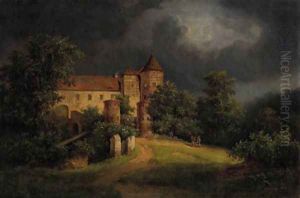Otto Friedrich Georgi Paintings
Otto Friedrich Georgi was a German artist born on April 21, 1819, in Leipzig, Germany. He is not widely known in the broader spectrum of art history, and specific details about his life and career can be somewhat obscure. However, during his lifetime, he made contributions to the world of art primarily as a painter, although the extent and recognition of his work may not parallel that of his more famous contemporaries.
Georgi began his artistic education in his hometown of Leipzig before moving on to further his studies. It was common for artists of that period to travel to art hubs such as Paris or Rome to refine their skills, but it is not well-documented whether Georgi had such opportunities. His artistic style and the subjects of his works are not well chronicled, and as a result, he remains a relatively minor figure in the history of 19th-century German art.
Despite the lack of widespread fame, Otto Friedrich Georgi was part of the rich tapestry of European artists who contributed to the cultural scene during a period that saw significant transformations in art. The 19th century was marked by the emergence of movements such as Romanticism, Realism, and Impressionism. Although Georgi's individual impact on these movements is not clear, his work would have been influenced by the broader shifts in aesthetic approaches and themes of the era.
Georgi's death occurred on November 19, 1874, in Leipzig. The legacy of an artist like Otto Friedrich Georgi serves as a reminder that for every renowned master, there are countless other artists whose lives and works are quietly woven into the history of art. They may not have achieved widespread fame, but they each played a role in the development and perpetuation of artistic expression during their time.
